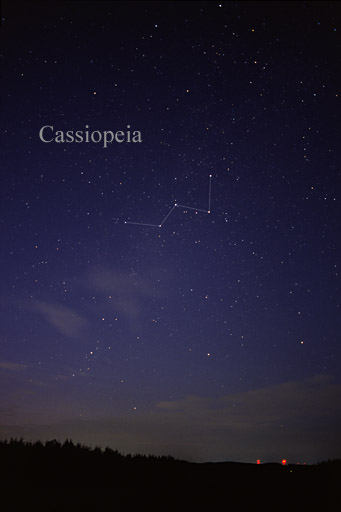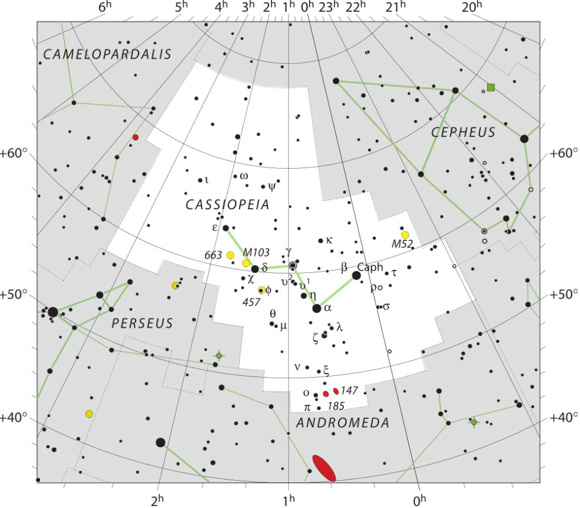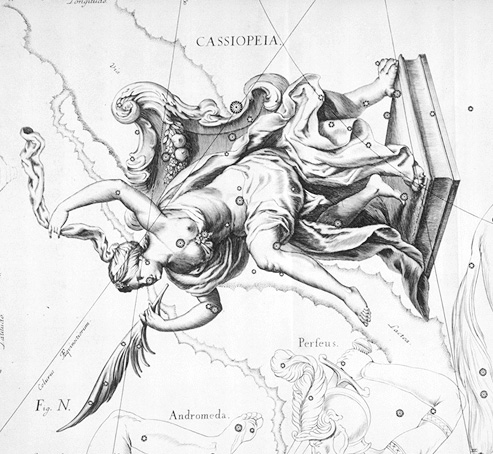Erick wrote to ask for information on Cassiopeia’s Chair. That’s a lovely old-fashioned name for the constellation Cassiopeia. In the 1930s, the International Astronomical Union (IAU) dropped the word Chair from this constellation’s name, calling her simply Cassiopeia the Queen. But sky watchers still see the Chair in the W or M shape of this constellation, and speak of it.
In skylore and in Greek mythology, Cassiopeia was a beautiful and vain queen of Ethiopia. It’s said that she committed the sin of pride by boasting that both she and her daughter Andromeda were more beautiful than Nereids, or sea nymphs. Pridefulness, in mythology, is never wise.

For much of the Northern Hemisphere, Cassiopeia is circumpolar, that is, out all night throughout the year. In February, Cassiopeia appears in the northwest at nightfall and low in the north-northeast before dawn, as depicted above. Image via AlltheSky.com.
Her boast angered Poseidon, god of the sea, who sent a sea monster (Cetus the Whale) to ravage the kingdom. To pacify the monster, Cassiopeia’s daughter, Princess Andromeda, was left tied to a rock by the sea. Cetus was about to devour her when Perseus the Hero happened by on Pegasus, the Flying Horse.
Perseus rescued the princess, and all lived happily . . . and the gods were pleased, so all of these characters were elevated to the heavens as stars.

In the 1930s, the IAU – an organization of professional astronomers – decided to define boundaries and “officially” name 88 constellations. This is the realm of night sky they identified as Cassiopeia. Read more from the IAU.
But – because of her vanity – Cassiopeia suffered an indignity. At some times of the night or year, this constellation has more the shape of the letter M, and you might imagine the Queen reclining on her starry throne. At other times of year or night – as in the wee hours between midnight and dawn in February and March – Cassiopeia’s Chair dips below the celestial pole. And then this constellation appears to us on Earth more like the letter W.
It’s then that the Lady of the Chair, as she is sometimes called, is said to hang on for dear life. If Cassiopeia the Queen lets go, she will drop from the sky into the ocean below, where the Nereids must still be waiting.

Cassiopeia as depicted by Johannes Hevelius in the 1600s.
Bottom line: This post tells you how to find the constellation Cassiopeia the Queen on winter evenings, and it explains the mythology of this constellation.
A planisphere is virtually indispensable for beginning stargazers. Order your EarthSky Planisphere.
Enjoying EarthSky so far? Sign up for our free daily newsletter.
from EarthSky https://ift.tt/39OBrhJ
Erick wrote to ask for information on Cassiopeia’s Chair. That’s a lovely old-fashioned name for the constellation Cassiopeia. In the 1930s, the International Astronomical Union (IAU) dropped the word Chair from this constellation’s name, calling her simply Cassiopeia the Queen. But sky watchers still see the Chair in the W or M shape of this constellation, and speak of it.
In skylore and in Greek mythology, Cassiopeia was a beautiful and vain queen of Ethiopia. It’s said that she committed the sin of pride by boasting that both she and her daughter Andromeda were more beautiful than Nereids, or sea nymphs. Pridefulness, in mythology, is never wise.

For much of the Northern Hemisphere, Cassiopeia is circumpolar, that is, out all night throughout the year. In February, Cassiopeia appears in the northwest at nightfall and low in the north-northeast before dawn, as depicted above. Image via AlltheSky.com.
Her boast angered Poseidon, god of the sea, who sent a sea monster (Cetus the Whale) to ravage the kingdom. To pacify the monster, Cassiopeia’s daughter, Princess Andromeda, was left tied to a rock by the sea. Cetus was about to devour her when Perseus the Hero happened by on Pegasus, the Flying Horse.
Perseus rescued the princess, and all lived happily . . . and the gods were pleased, so all of these characters were elevated to the heavens as stars.

In the 1930s, the IAU – an organization of professional astronomers – decided to define boundaries and “officially” name 88 constellations. This is the realm of night sky they identified as Cassiopeia. Read more from the IAU.
But – because of her vanity – Cassiopeia suffered an indignity. At some times of the night or year, this constellation has more the shape of the letter M, and you might imagine the Queen reclining on her starry throne. At other times of year or night – as in the wee hours between midnight and dawn in February and March – Cassiopeia’s Chair dips below the celestial pole. And then this constellation appears to us on Earth more like the letter W.
It’s then that the Lady of the Chair, as she is sometimes called, is said to hang on for dear life. If Cassiopeia the Queen lets go, she will drop from the sky into the ocean below, where the Nereids must still be waiting.

Cassiopeia as depicted by Johannes Hevelius in the 1600s.
Bottom line: This post tells you how to find the constellation Cassiopeia the Queen on winter evenings, and it explains the mythology of this constellation.
A planisphere is virtually indispensable for beginning stargazers. Order your EarthSky Planisphere.
Enjoying EarthSky so far? Sign up for our free daily newsletter.
from EarthSky https://ift.tt/39OBrhJ

Aucun commentaire:
Enregistrer un commentaire